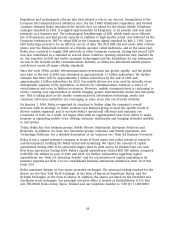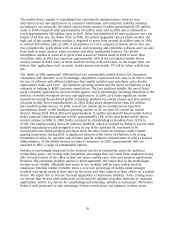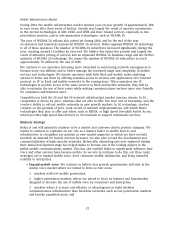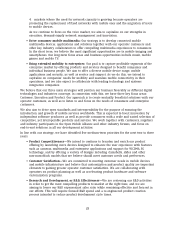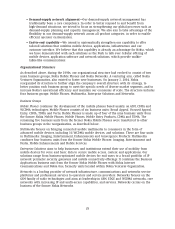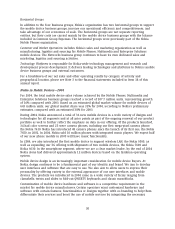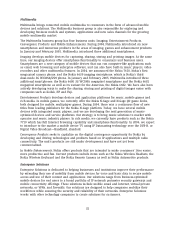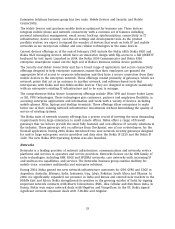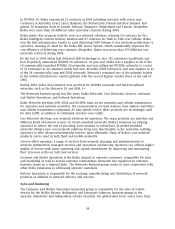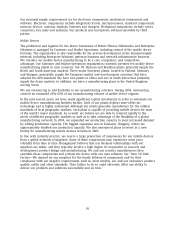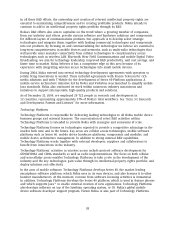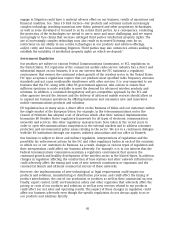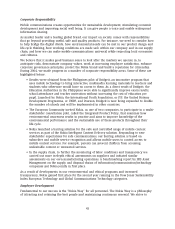Nokia 2004 Annual Report Download - page 35
Download and view the complete annual report
Please find page 35 of the 2004 Nokia annual report below. You can navigate through the pages in the report by either clicking on the pages listed below, or by using the keyword search tool below to find specific information within the annual report.In WCDMA 3G, Nokia announced 13 contracts in 2004 including contracts with seven new
customers in Australia, Israel, Libya, Malaysia, the Netherlands, Poland and New Zealand, and
gained 3G expansion deals in Austria, Bahrain, Singapore, Switzerland and Taiwan. Altogether,
Nokia won more than 40 different radio networks contracts during 2004.
Nokia made clear progress with its new core network solutions, winning 20 contracts for the
Nokia Intelligent Content Delivery solution and 27 contracts for Push to Talk over Cellular. Nokia
was the first infrastructure vendor to start delivering 3GPP Release 4 core network architecture to
operators, winning 25 deals for the Nokia MSC Server System, which considerably improves the
cost-efficiency of delivering voice minutes. Altogether, Nokia won more than 150 different core
networks contracts during 2004.
By the end of 2004, Nokia had delivered GSM technology to over 130 customers worldwide and
had 45 publicly announced WCDMA 3G references. At year-end, Nokia was a supplier to 28 of the
63 commercially launched WCDMA 3G networks, and was rolling out WCDMA networks to a total
of 33 customers in 22 countries. Nokia had over 40 public EDGE references, and was supplier to 21
of the 38 commercially launched EDGE networks. Network’s remained one of the industry leaders
in the mobile infrastructure market globally with the second highest market share at the end of
2004.
During 2004, Nokia also launched new products for WCDMA networks and fixed broadband
networks, such as the Metrosite 50 and ADSL 2+.
The Networks business group has five units: Radio Networks, Core Networks, Services, Customer
and Market Operations, and Delivery Operations.
Radio Networks develops GSM, EDGE and WCDMA radio access networks and cellular transmission
for operators and network providers. The main products are base stations, base station controllers
and cellular transmission equipment. As data speeds evolve, these products are increasingly used
for data traffic in addition to traditional wireless voice traffic.
Core Networks develops core network solutions for operators. The main products are switches and
different kinds of network servers. In circuit-switched networks, Nokia’s solutions are helping
operators to reduce the cost of providing voice minutes to subscribers. In packet-switched
networks, Nokia’s new core network solutions bring new functionality to the networks enabling
operators to offer advanced multimedia services more efficiently. Many of Nokia’s core network
products can be used in both fixed and mobile networks.
Services offers operators a range of services from network planning and implementation to
network optimization, managed services and operations outsourcing. Operators can achieve higher
quality of service with lower operating and capital expenditures by improving and automating
their processes with our tools and services.
Customer and Market Operations is the Nokia channel to operator customers, responsible for sales
and marketing as well as overall customer relationships. Networks has organized its customer
business teams on a regional basis. The Networks business group works in close cooperation with
other Nokia businesses in addressing operator customers.
Delivery Operations is responsible for the sourcing, manufacturing and distribution of network
products, in addition to network delivery and services.
Sales and Marketing
The Customer and Market Operations horizontal group is responsible for the sales of mobile
devices for the Mobile Phones, Multimedia and Enterprise Solutions business groups to the
operator, distributor and independent retailer channels. Our global sales force covers more than
34


